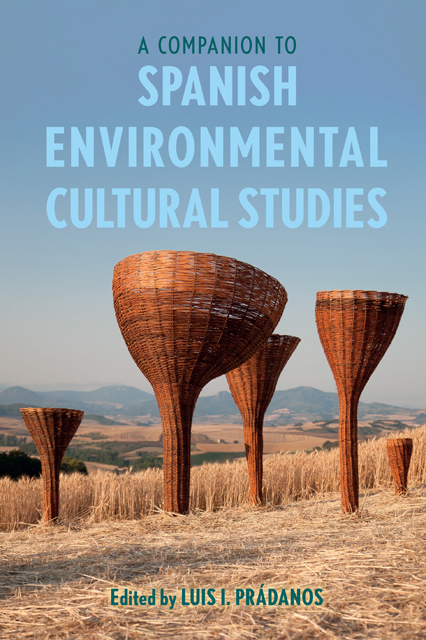Book contents
- Frontmatter
- Contents
- List of Illustrations
- List of Contributors
- Note on the Translations
- Acknowledgements
- Introduction: Spanish Environmental Cultural Studies
- Part I Environmental Cultural History and Political Ecology
- Part II Water and Power
- Part III Ecologies of Memory and Extractivism
- Part IV Animal Studies and Multispecies Ethnographies
- Part V Food Studies and Exploitative Ecologies
- Part VI Ecofeminism
- Part VII (Neo)Colonial and Racialized Ecologies
- Part VIII Tourism and the Environmental Imagination
- Part IX Eco-Mediation and Representation
- Part X Trash and Discard Studies
- Bibliography
- Index
4 - The Message in a Bottle: Waterworks in Modern and Contemporary Spain
Published online by Cambridge University Press: 08 June 2023
- Frontmatter
- Contents
- List of Illustrations
- List of Contributors
- Note on the Translations
- Acknowledgements
- Introduction: Spanish Environmental Cultural Studies
- Part I Environmental Cultural History and Political Ecology
- Part II Water and Power
- Part III Ecologies of Memory and Extractivism
- Part IV Animal Studies and Multispecies Ethnographies
- Part V Food Studies and Exploitative Ecologies
- Part VI Ecofeminism
- Part VII (Neo)Colonial and Racialized Ecologies
- Part VIII Tourism and the Environmental Imagination
- Part IX Eco-Mediation and Representation
- Part X Trash and Discard Studies
- Bibliography
- Index
Summary
As the Tajo and Tiétar Rivers flow toward the Portuguese border from mountain ranges in mid-eastern Spain, they approach one another and run parallel for almost 125 kilometers, without actually touching, prior to their confluence in what is today Monfragüe National Park in western Spain. In 1959, this particularity was attractive to engineers enrolled in the project of redistributing Spain’s waterways, a signature policy of the Franco dictatorship. The two rivers running alongside one another allowed for the construction of twin hydroelectric dams, with a tunnel serving as a spillway connecting the two reservoirs.
The morning of 22 October 1965, approximately 4,000 workers neared completion of the Torrejón-Tajo Dam project, moving at breakneck speed in the emptied out basin of the Tajo. Since many workers migrated from southern Spain, among other agrarian areas, their families traveled with them, living in makeshift tents above the river basin. As their families finished breakfast, Hidroeléctrica Española (now Ibérdrola) decided to test the maximum level of the reservoir located on the northern Torrejón-Tiétar. At this moment, a breach in the tunnel caused water to pour into the Tajo, killing (officially) 54 workers. While the number is likely to have been double, the event already constitutes the worst labor accident in Spain’s history (Monforte). Yet the disaster barely made the news. It appears the fascist regime learned from the Ribadelago disaster coverage in 1959, when at least 144 local people drowned after the Vega de Tera reservoir failed. If it were not for a monolith dedicated to the victims in 2016, the Monfragüe reservoirs would completely obscure what happened under their surface.
This history offers insight into the Francoist political ecology that dramatically re-shaped Iberian waterways through a rapid buildup of hydraulic infrastructure, or waterworks. Infrastructure itself is the subconscious of modernity: the below-structure that goes unnoticed when everything is fine, which Christopher Bollas calls an “unthought known” (Rubenstein, p. 576). Monfragüe suggests that investigating Francoist waterworks exposes infrastructure not as a public good but rather as a form of necropolitics, a political order arbitrarily deciding who lives and who dies. Yet this submergence zone remains largely unthought of, until a drought exposes what lies beneath. Even then, it is difficult to decipher such a sight without understanding the history of Francoist waterworks.
- Type
- Chapter
- Information
- A Companion to Spanish Environmental Cultural Studies , pp. 61 - 67Publisher: Boydell & BrewerPrint publication year: 2023



